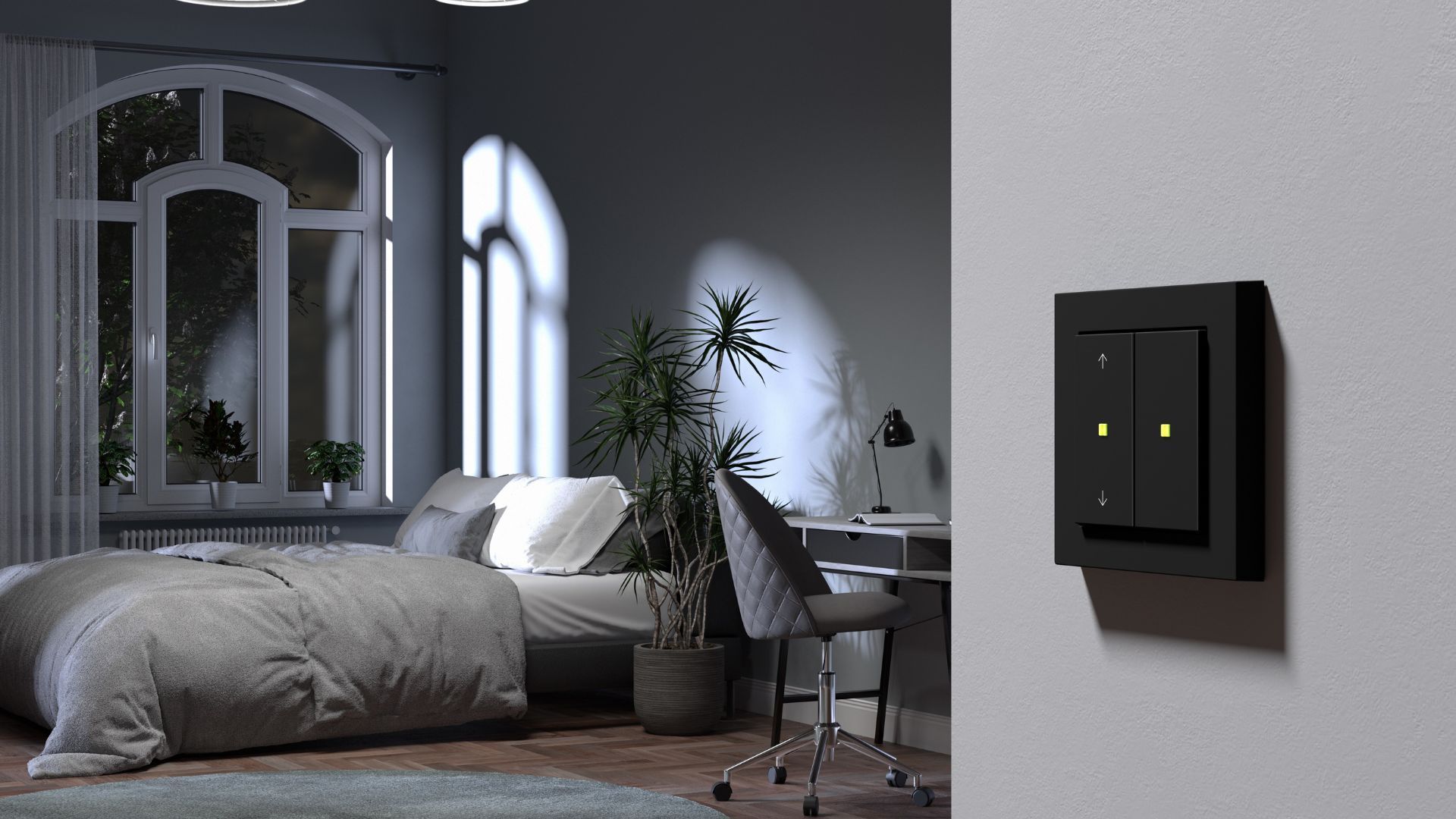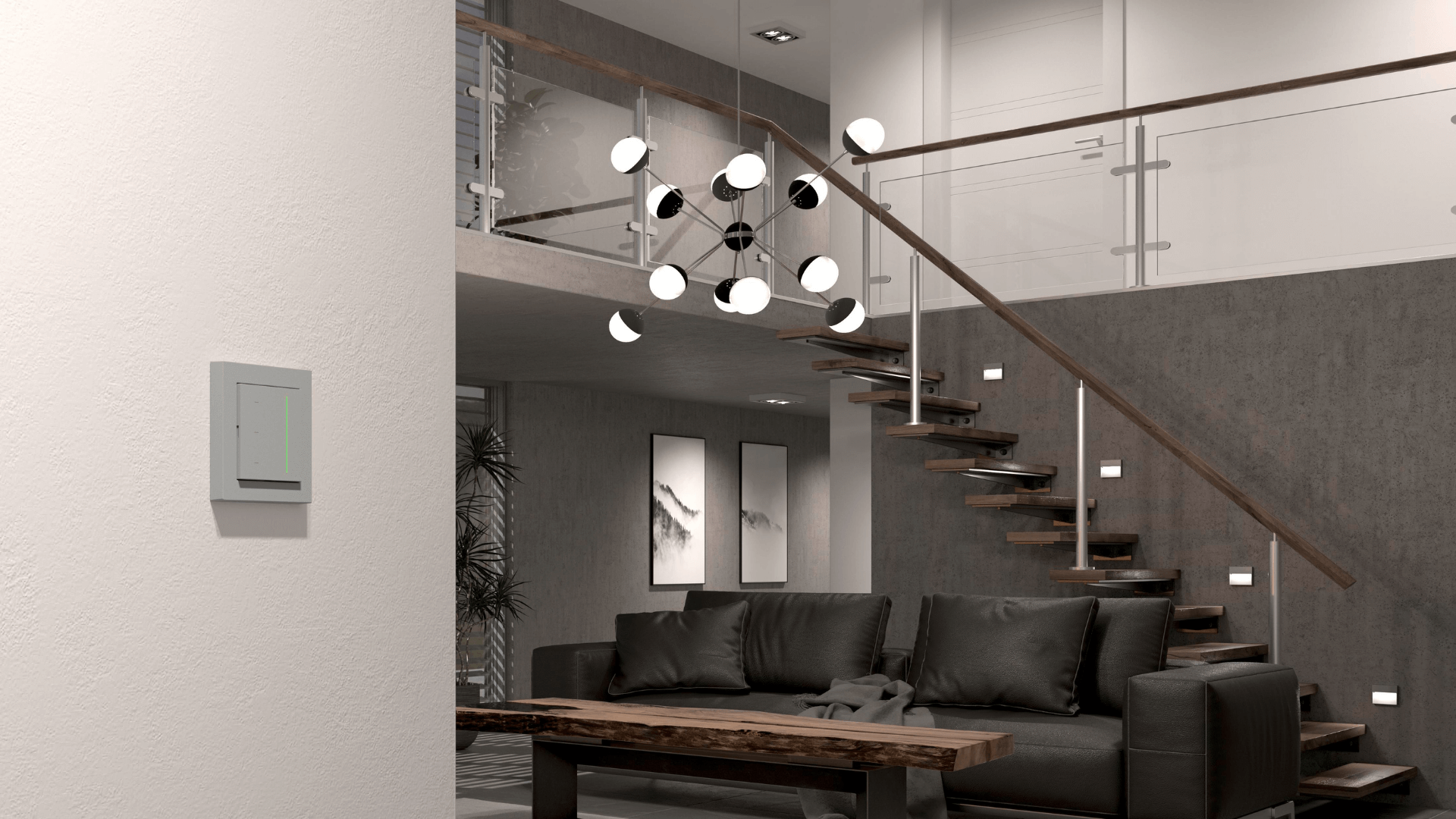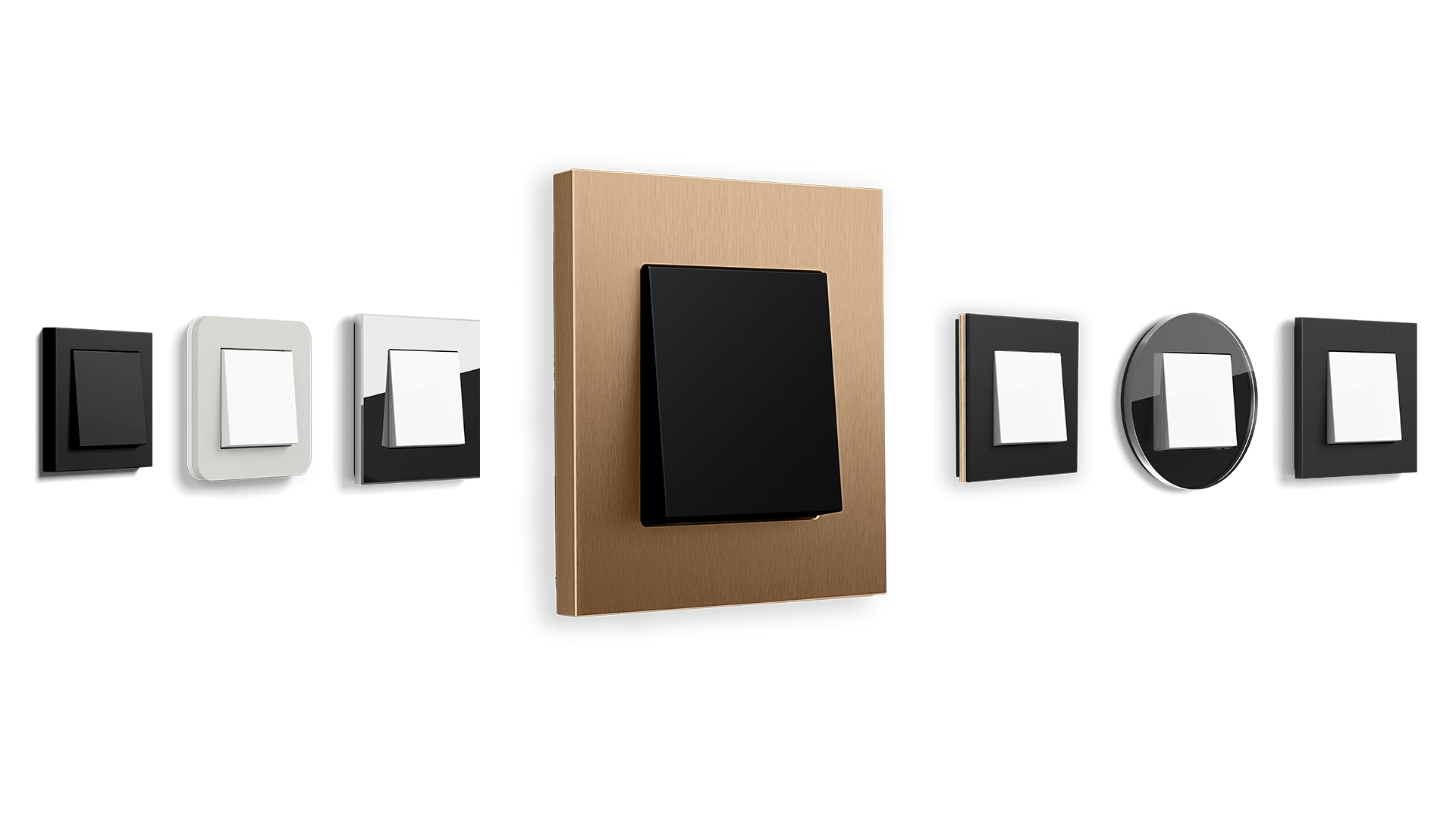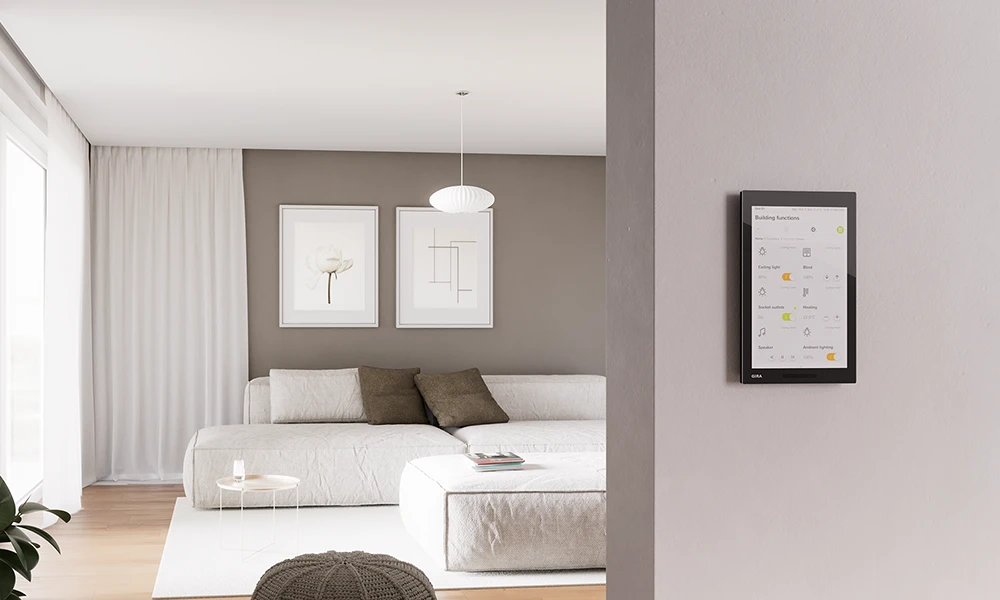
We’ve all heard about Smart Homes. But did you know that depending on the type of network, there are different systems to choose from? For those wondering which one might be the best fit, here’s an overview of all options – cabled and radio-based.
The first steps towards smart living
Smart Homes can make your life easier in many ways. By way of example, a modern security system will send you alerts on your smartphone in case of emergency. Or you could use automated heating to reduce your energy expenditure. Functions like these (and a lot more) work with either wired or wireless systems.
Which solution is right for you always depends on your living situation and individual needs. You should definitely know the benefits of both options before making a decision. To help you get started, we’ve summed up the most important features and differences.
Cabled Gira KNX system for maximum functionality
KNX is the international standard for connected building technology that enables smart control of functions such as lights, blinds, and heating. This allows you to configure automated processes according to your daily routines: if the heating turns on in the afternoon, for instance, you’ll be welcomed by a cosy warm home after work. A great benefit of cabled KNX systems is that you can connect a huge number of devices from different manufacturers within your Smart Home.
Planning in advance for KNX installations
In order to set up a KNX system, you need a green cable in addition to the regular power supply line. This cable links all KNX compatible elements in your Smart Home to each other. Since it is integrated into the wall, KNX systems are most suitable for new builds or large renovation projects. Theoretically speaking, you can also install them in existing buildings – but you would have to tear open walls for that purpose.
Smart control with Gira KNX
Here’s an overview of all control options for your Smart Home:
Here’s an overview of all control options for your Smart Home:
Server: Using the Gira X1 server, you can configure and customise parts of your KNX system yourself. Alternatively, the Gira HomeServer is a good choice if you want to program highly complex scenarios.
Apps: Your entire building technology can also be controlled via the Gira Smart Home app. One glance at your smartphone or tablet will tell you exactly what’s going on at any point in time. The security module Gira S1 furthermore enables you to access the system remotely, without putting your personal data at risk.
Operating elements: the Gira G1 serves as the central control unit. Mounted on the wall, it is connected to all smart functions within your home. Additionally, you can rely on smart switches such as the Gira pushbutton sensor 4.
Voice control: integrating Amazon Alexa or the Google Assistant allows you to regulate your lights, blinds, or heating via voice command.
Wired Gira One system: Smart Home made even easier
Also based on the green KNX cable, Gira One can be installed by an electrical contractor near you and adapted to your needs. The Gira One system is the right choice for you if you want smart convenience features and would like to benefit from a higher quality of life in your daily routine.
Also based on the green KNX cable, Gira One can be installed by an electrical contractor near you and adapted to your needs. The Gira One system is the right choice for you if you want smart convenience features and would like to benefit from a higher quality of life in your daily routine.
The system offers numerous application and automation options that allow you to easily control and interconnect blinds, heating and lighting. Perhaps you also want to integrate a few additional devices such as Sonos speakers or Phillips Hue lights? If so, Gira One is a perfect match. You can operate the system via buttons for Gira One and KNX, the Gira G1, or even via the Gira Smart Home app while on the go.
Another advantage: the quick and easy start-up of the system. This is done via the Gira Project Assistant (GPA) with the help of assistant-guided step-by-step instructions and guides you through the entire setup process with intuitive video tutorials. There is also the option of remote maintenance, which eliminates the need for you to organise appointments with the electrical contractor.
Discover how to quickly and easily create a future-proof smart home with Gira One.
Flexible without cabling: wireless Smart Homes
Installing a KNX system usually requires a considerable amount of construction work. But that doesn’t mean you can’t make your home smart without cabling: Gira offers several solutions which are easy to retrofit in existing buildings.
Ideal for a smart start: the Gira System 3000
You want to automate your home but don‘t even know where to begin? The Gira System 3000 will provide a solid foundation. It can be retrofitted by simply exchanging switch inserts and mounting the top unit of your choice. And just like that, you’re able to adjust lights, blinds, and heating according to your daily routines: manually via switch, automatically based on time schedules, or via app. The Gira System 3000 thus allows you to integrate smart technology with minimum effort.
Overall, you can choose between five types of operating top units – including the Gira System 3000 touch top unit or the operating top unit Bluetooth. In combination with the Gira System 3000 app, you have the option to control lights and blinds according to automated schedules. This proves particularly convenient when you’re not home and want to scare off potential intruders by simulating your presence.
Gira KNX RF Multi: less effort, more flexibility
The abbreviation “RF“ stands for “radio frequency“ and refers to a special type of KNX Smart Home: the wireless Gira KNX RF Multi system can be set up without cabling. All you need is a conventional 230 V installation for switches and socket outlets. Since the system works via radio transmission, you won’t have to lay additional cables or tear open walls. This allows for quick and easy retrofittings in older buildings or rental flats. The functional inserts of the Gira System 3000 thereby serve as the basis for the Gira KNX RF top units.
Intuitive control in wireless Smart Homes
Similar to cabled KNX systems, Gira RF for KNX offers a wide range of functions and possibilities to automate daily processes. The radio-based system includes the same control options as cabled KNX Smart Homes. In addition, you can use wireless operating elements such as battery-powered Gira RF pushbutton sensors for KNX or Gira RF handheld transmitters for KNX. Both are part of the Gira System 55 and thus compatible with numerous frame variants from the Gira design lines – so that you’ll always find something to match your personal interior style.
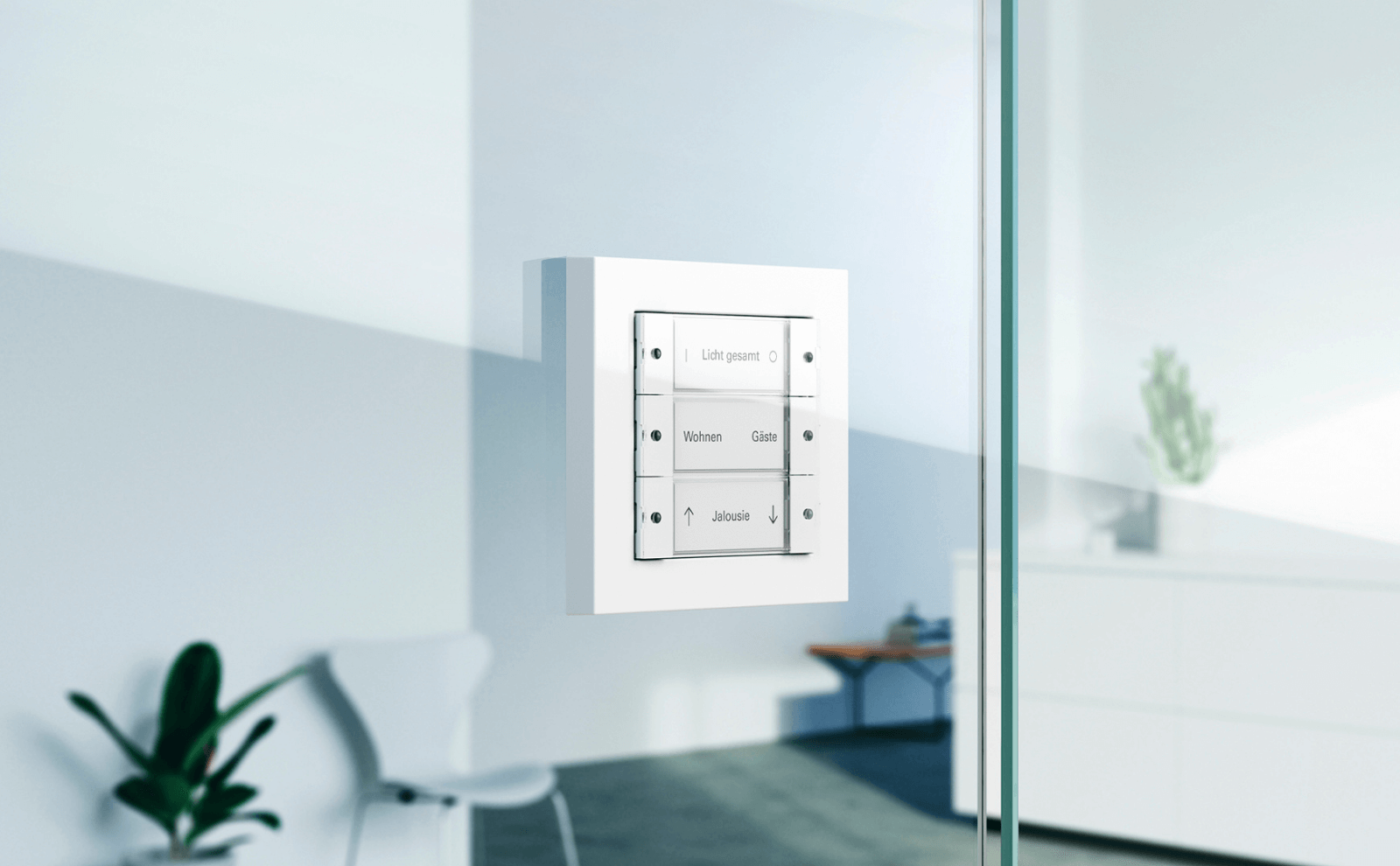
Safe networks with KNX Secure
Thanks to the independent standard KNX Secure, you can be sure that your data remain protected in both wired and wireless KNX Smart Homes at all times. This includes data integrity, authentication, encryption, and regular updates. With the remote access module Gira S1, you can monitor your Smart Home via app from anywhere just as safely.
Cabled or wireless: which Smart Home suits your needs best?
There is no “one-fits-all” solution when it comes to smart living. In the end, your individual requirements determine whether you should choose a wired or wireless network.
You’re already planning or building a new home? In that case, we recommend a cabled KNX system for maximum convenience.
If you live in a rental flat or own an older home, you can opt for a radio-based alternative such as the Gira System 3000 or Gira RF for KNX instead. This way, you’ll still benefit from a large range of smart functions without major renovation work.

